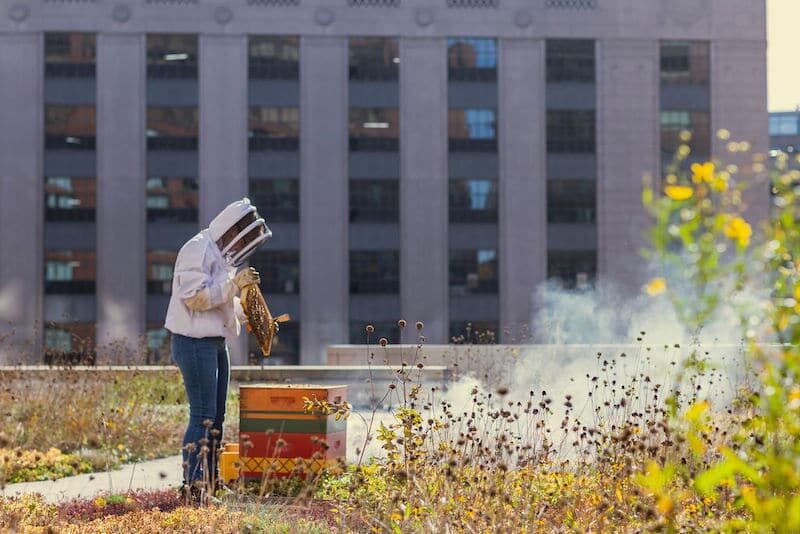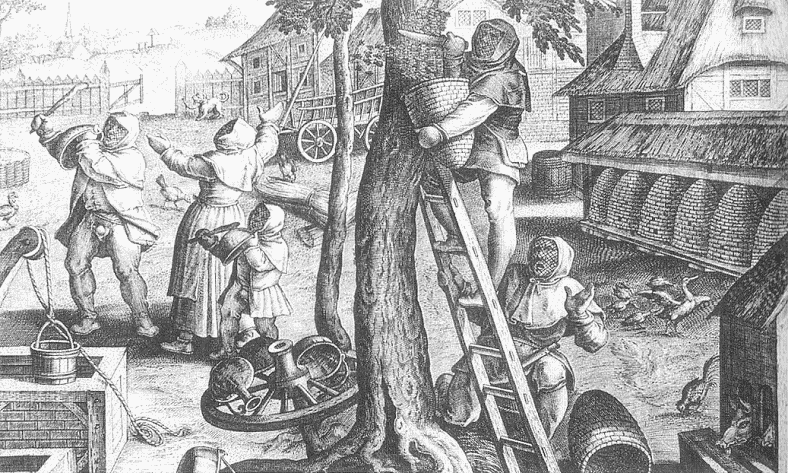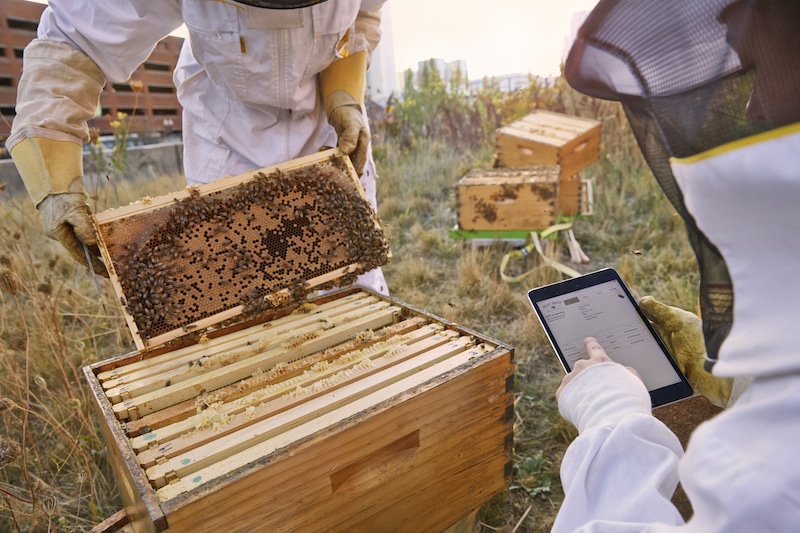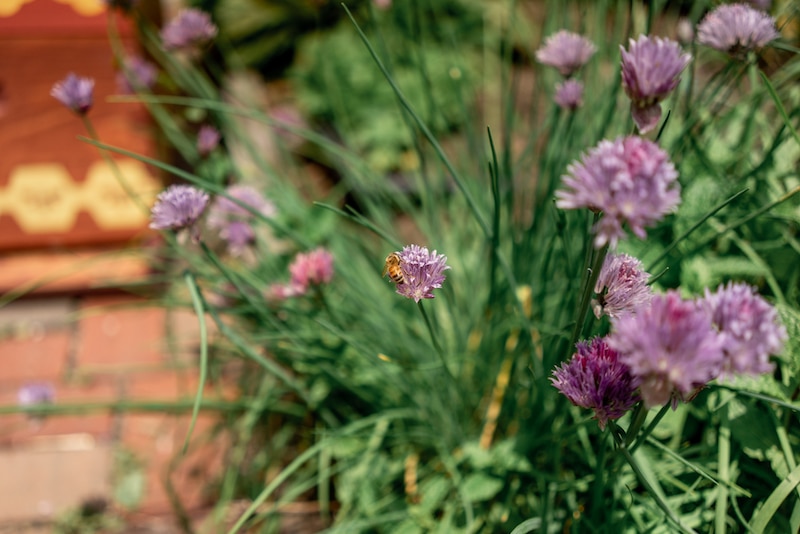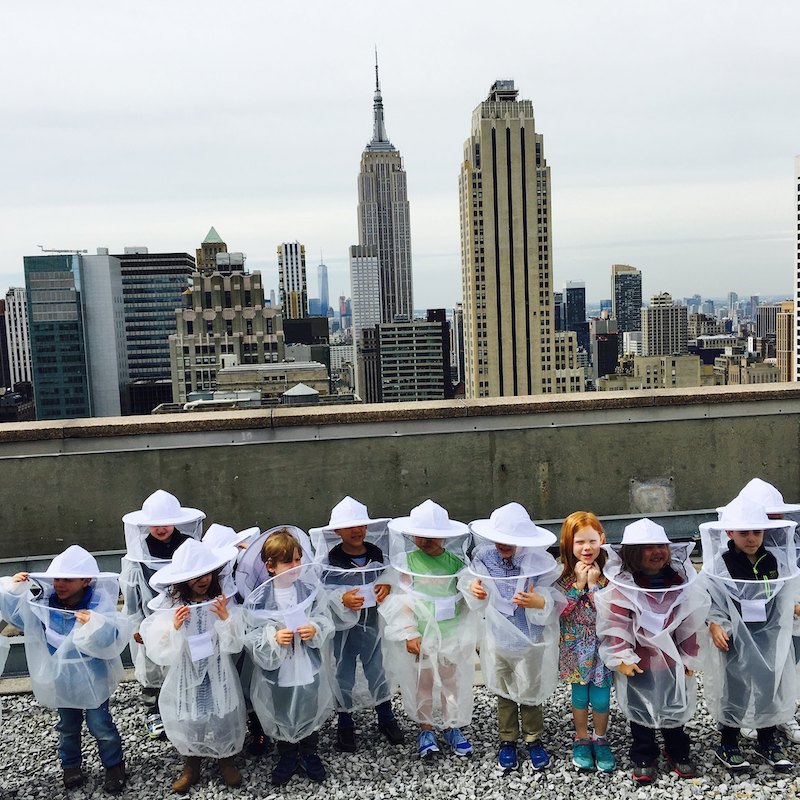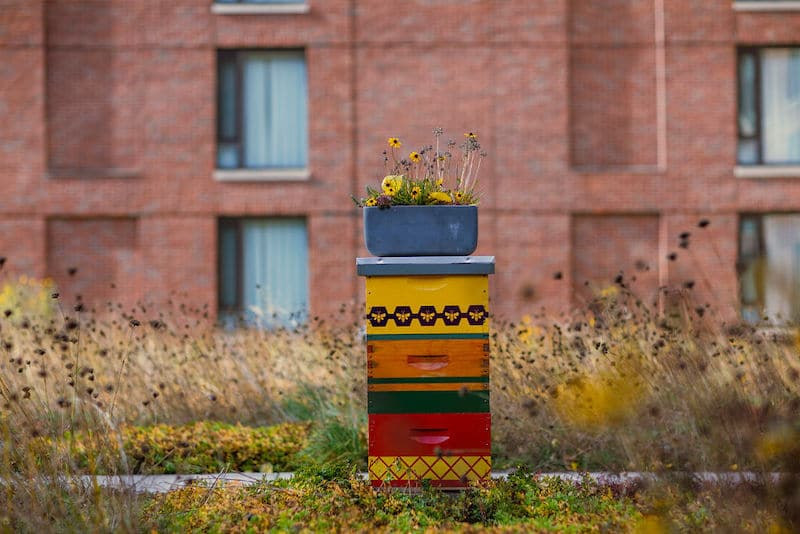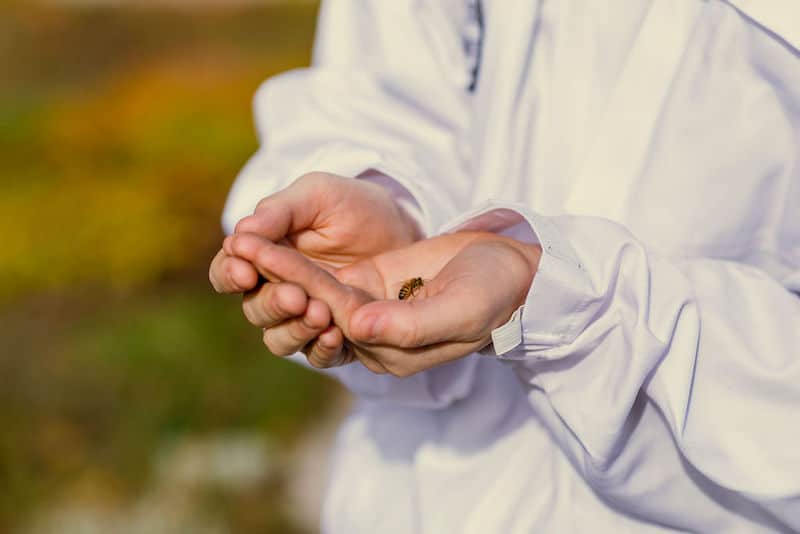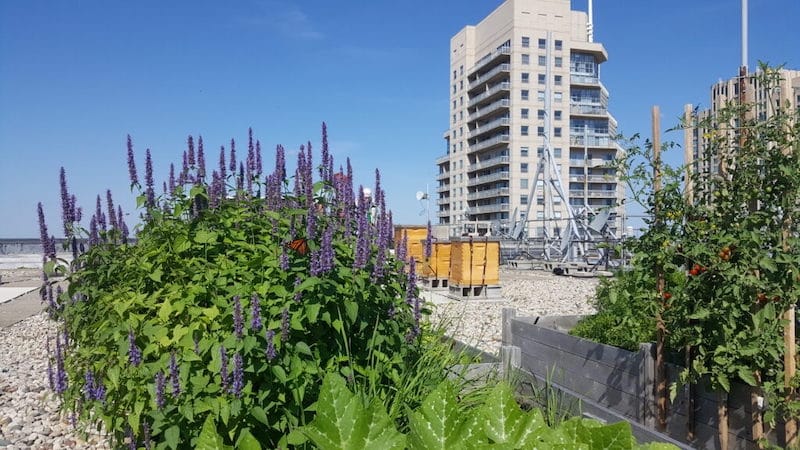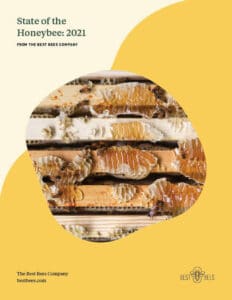Contents:
- What is Urban Beekeeping?
- History of Urban Beekeeping
- Benefits of Urban Beekeeping
- Challenges of Urban Beekeeping
- Problems with Urban Beekeeping
- Urban Beekeeping Laws
- Urban Beekeeping Best Practices
- Best Bees Stance on Urban Beekeeping
- Urban Beekeeping FAQ’s
What is Urban Beekeeping?
Simply put, urban beekeeping is the practice of working with bees in cities. This can include honey bees as well as solitary bees such as mason, leaf cutter, digger, and some social bees like carpenters and bumbles. Most people work with honey bees because of the long history of the practice, dating back over 9,000 years. For urban beekeeping using honey bees, just like rural and suburban beekeeping, the practice includes founding colonies with queens and worker bees, housing them, providing supplemental feeding when needed, helping them to fight off pests, and when surpluses exist, harvesting honey. Many still find the idea of keeping bees in cities strange, perhaps because we think of suburbs and rural areas as more natural environments, and cities as largely man-made spaces largely devoid of nature.
–– Interested to know how the bees are doing? Download our State of the Honey Bee Report now ––
Through studying urban beekeeping for more than a decade, scientists at The Best Bees Company have learned that cities are far from being ecological deserts. Rather, cities are vibrant environments for pollinators. Cities offer bees a surprisingly diverse choice of pollen-bearing plants among parks, playgrounds, backyards, street trees, and median strips. There’s a growing urban agricultural movement turning empty lots and rooftops into lush garden habitat. DNA samples collected from Best Bees honey have shown that urban bees pollinate eight times more species than then suburban bees. Urban beehives have higher winter survival rates and produce 56% more honey than their country cousins.
If urban beekeeping is proving to be so productive, why aren’t there more urban hives and urban beekeepers?
A Brief History of Urban Beekeeping
Image Source: The Beekeeping Bible
While mankind has been collecting honey from beehives at least since cave-dwelling people in modern day Spain documented it, honey bees are not native to the Americas—they were introduced into English colonies in the 1670’s. For generations, North American beekeeping was an integral part of family farming, and until the mid-20th century, the American food system was still largely locally based around small farms. With supermarkets, fast food and agribusiness taking control of most of our food system after WWII, people lost touch with the sources of their food, honey and beekeeping included.
The call for city bees was first taken up in 1980’s Paris, where experimental hives on the roof of the famed Opera Garnier were so successful, they introduced a new industry in France: Urban Beekeeping. Today there are over 3,000 hives in the greater metropolitan Paris area alone, and urban beekeeping has spread around the world. In the U.S., the movement was initially hampered by municipal legislation restricting the raising of farm animals in cities—bees included. But beekeeping activists persisted, and U.S. cities began to change their laws. New York legalized urban beekeeping in 2010; Boston in 2013; LA in 2015.
Over the past few decades, environmental concern has brought about a growing interest in how and where food is produced. Sustainable and artisanal food movements have helped spawn a renaissance in urban farming and beekeeping. Where permitted, urban beekeeping is part of a growing movement to make cities—and their buildings—greener. Some municipalities even offer incentives to building owners and managers to install rooftop gardens and beehives to support sustainability and biodiversity efforts.
With the advent of urban farming and beekeeping, ecologists are looking more closely at the role pollinators play not only in agricultural yields, but in sustainability across all systems.
5 Benefits of Urban Beekeeping
Urban beekeeping brings many benefits to cities in the U.S. and around the world–from scientific data collection, to biodiversity, and supporting green initiatives.
1.Provides Critical Data for Studies Focused on Pollinator Health
Honey bees, as an indicator species, are an excellent source of data on both pollinator and environmental health. Creating greener cities will mean testing a host of different initiatives to learn what works best; urban honeybees may be an important tool in measuring program effectiveness.
2.Pollinates Local Urban Agriculture and Greenery
Urban beekeeping helps to build local food systems by pollinating urban farms and gardens and providing city dwellers with locally produced honey. Honey bees play a critical role in our food system accounting for the pollination of over 85 different crops. Without honey bees, our agricultural system would collapse and the population of native pollinators would be unable to replace the capacity of honeybees. Local honey, derived from a host of local plants, can strengthen immune systems.
3.Connects Urban Citizens to Nature
Honey bees have long been associated with the goodness of nature; urban beehives, as visible symbols of nature in the city, help city residents and workers reconnect with their natural environment.
4.Supports Sustainable Building Initiatives
Urban beekeeping helps to make commercial building more sustainable by raising LEED scores and qualifying building owners for other types of sustainability certifications.
5.Engages Tenants and Employees with a Nature-Based Amenity
Keeping bees is an easy way to demonstrate a commitment to sustainability, enhancing brand image for hotels, restaurants, and property managers. Beekeeping is also a great way to engage constituents in corporate sustainability through pollinator education programs and honey-themed events.
3 Challenges Facing Urban Beekeepers
While urban beekeeping practices are similar to those in suburban and rural areas, urban beekeepers face unique challenges when it comes to hive placement, human/bee interaction, and habitat loss.
1.Urban Beehive Placement
The main challenge is not lack of places to put beehives in cities but challenging the status quo. With space at a premium in cities, it’s often hard to find ground-level plots of land that aren’t already in use. Instead of looking on the ground, we should look up—to building roofs.
In the words of Best Bees founder, Dr. Noah Wilson-Rich, “Roofs are cities’ biggest under-utilized asset.” As property owners begin to think about how to make their buildings more sustainable, roofs come into play, and while extensive rooftop gardens can require structural changes to support them, beehives are an easy and low-cost first step towards roof greening.
2.Human/Bee Interaction
While honey bees have been bred for safety and are no threat to humans if left undisturbed, the close quarters people live and work in cities mean that hive sites must be chosen carefully to minimize human/bee interaction.
3.Pollinator Habitat Loss
Loss of habitat is a problem everywhere for pollinators, but in growing cities such as New York, Houston and San Francisco, real estate development is making the problem acute. The solution, and one that many real estate developers are embracing, is the addition of garden-level pollinator habitat and rooftop gardens on new and renovated structures.
“Recent studies have shown the possible success with adding green spaces within cities as habitat for different pollinator groups, even in small spaces.” reports Emily O’Neil, Staff Scientist at Best Bees. “It should be noted,” she adds, “that we should apply near-natural concepts in design and maintenance to create a wide range of flower diversity.”
Urban Beekeeping Problems and Misperceptions
Does Urban Beekeeping Negatively Impact Native Pollinators?
Bees are critically important pollinators, and yet they’re dying. This is likely a small part of the larger “insect apocalypse” whereby human activity is likely playing a detrimental role. Data from the Best Bees network of beehives indicate that bees are actually thriving in urban areas. Best Bees’ work over the past decade in sharing these findings have allowed them to advance the conversation with the general public that urban beekeeping is beneficial to the health and preservation of these pollinators.
The conversation now is starting to include not only honey bees but other species of pollinators, of which there are 200,000 total, including 4,000 species native to the United States. New research is helping us to better understand how pollinators coexist under different conditions. The results of some studies indicate that there are situations where honey bees compete directly with other pollinators over access to pollen and nectar forage. During the writing process for Noah Wilson-Rich’s book, The Bee: A Natural History (Princeton University Press, 2014), he delved deeply into a search to find specialist bees. Time and time again, he found that all bees were more generalists, meaning that they visit many types of flowers rather than one type alone. And so when many species of bees are dying in agricultural areas with monoculture crops and pesticides, but thriving in similar habitats like urban areas with a diversity of flower forage, competition will be high. In times of high competition, honey bees have the advantage because of their sheer high population per beehive; most other species of bees are solitary (meaning they live alone and not in large colonies) and therefore are the underdog when resources are limited.
Homeowners and corporations can help to combat this competition by creating more robust pollinator habitat with native flowering plants that feed a growingly abundant pollinator population. Cities are the ultimate refuge for nature, where rural and suburban refugee pollinators come to thrive, establish, and repopulate. The key is to create more habitat.
And that’s exactly what most of the scientific studies call for when evaluating the impacts of urban beekeeping on other pollinator populations in any given area. Habitat can be created in two ways – 1) nesting, and 2) foraging. Nesting habitat is places for pollinators to live, such as beehives or bee hotels. Foraging habitat is places for pollinators to collect food from, like flowers, gardens, and green rooftops.
“Having a healthy pollinator ecological system in cities helps to create a virtuous circle where more pollinators lead to more plant pollination, which leads to a larger and more diverse floral systems that can support a larger and more diverse population of pollinators,” says Noah Wilson-Rich. “And yet, until we’ve completed our work at transforming cities from gray to green, there is still much more pollinator plant habitat that we need to establish in order to support these thriving pollinators.”
A study done in 2012 assessing bee biodiversity within urban settings measured a total of 56 bees, ants, and wasps (Hymenoptera), including species of digger bees (Andrena), bumble bees (Bombus), mason bees (Osmia), leaf-cutter bees (Megachile), and sweat bees (Halictus and Dialictus), within urban wild areas, community and botanical gardens, naturescape flower beds and backyards, and traditional flower beds and backyards.This study suggested that given the wide variation between each space, urban areas offer varying habitats to several different species of bees. Additionally, the study found a trend between the abundance of bee species and seasonal variation, with wild bees being more abundant in the spring season and honey bees peaking at the end of the summer.
Recognizing the importance of native pollinator health, Best Bees has continued to use data collected from their honeybee hives to drive scientific study of all pollinators forward and will continue to strive to create a healthy balance between species in the environments where they are active.
Are Beehives Dangerous to have Near Public Spaces?
Another presumed problem with urban beekeeping is the greater proximity of bees to people in urban environments. This is based on a misperception that bees are aggressive insects that are dangerous to people. Cartoons featuring swarms of angry bees chasing picnickers haven’t helped. Swarming bees, though, are actually the least likely to harm people—when they swarm, they’ve been sent out with their new queen, engorged with honey, to start a daughter colony, and are concerned with one thing only—finding a safe place to hive. Contrary to the cartoon image of angry bees, people needn’t fear them as they have been breeding them for millennia, and one of the traits bees have been bred for is safety. With urban beehives usually placed where human contact is minimal, the only places where urban dwellers are likely to encounter honeybees is passing them pollinating flowers in window boxes, trees, and gardens—the same kind of harmless contact suburban and rural dwellers have with bees.
Is Honey from Urban Beehives Dangerous to Eat or Less Healthy?
When we think of cities, we often think of unnatural environments—factories belching fumes, traffic clogged highways, toxic runoff from street waste. This leads some to be concerned about the purity of honey from urban hives. While bees may pass through potentially polluted environments, they spend most of their time on flowers or in hives. Extensive studies on urban honey demonstrate that it meets all regulatory standards and is completely safe for human consumption.
*To learn more about these studies, read “Floral Resource Competition Between Honey Bees and Wild Bees: Is There Clear Evidence and Can We Guide Management and Conservation?”, a research review published in Environmental Entomology in 2018.
Urban Beekeeping Laws
While beekeeping is legal in most cities, requirements and permitting vary by state and municipality, including the number and type of hives you can keep, where you can place them, and the need to alert neighbors within a defined radius of planned hives.
If concerned about urban beekeeping laws in your area, you can call your city clerk to enquire about regulations, or do a web search—most cities will post beekeeping ordinances online. To learn more about the challenges of beekeeping in your city, talk with local beekeepers–most areas have a local beekeeping association, and their members are eager to share their knowledge and experience.
At Best Bees, our staff regularly attend meetings within our local communities to be sources of information to policymakers when discussing urban beekeeping and urban agriculture.
Best Practices in Urban Beekeeping
Urban environments are as varied as the cities we live in—they can be cold or hot, dry, or wet; they can remain relatively constant, or show extremes of weather. Because of this, there’s no one-size-fits-all approach to urban beekeeping, instead there are many best practices, each adapted to different urban environments where bees are kept. Specialized knowledge and experiences are why Best Bees proudly hires Master Beekeepers and PhD-level employees for the highest level positions overseeing our beekeeping practices. We work closely with them to gather data on the impact of different interventions on bee health and honey production, and share successes among beekeepers in similar environments.
To learn more about our work with urban beekeeping, watch Noah Wilson-Rich’s TED Talk:
Best Bees’ Stance on Urban Beekeeping
Founded in Boston, and active now in 22 U.S. metropolitan areas, The Best Bees Company has been an advocate of urban beekeeping for over a decade. In that time, we have studied honey bees in a host of different urban conditions. Working with a non-profit scientific partner, the Urban Beekeeping Lab, The Best Bees Company has built the largest database of honey bee health using standardized beekeeping methods in North America. Best Bees shares the findings with scientific and beekeeping communities, commercial and residential clients, and with citizen scientists worldwide.
“The evidence to us is overwhelmingly positive.” says Noah-Wilson-Rich, the founder and Chief Science Officer of Best Bees. “As part of the environment, pollinators of all kinds belong in our cities. We must acknowledge that pollinators are threatened worldwide, but they seem to be thriving in cities. If we’re to build a truly sustainable future, our cities need more bees and more urban beekeepers whose beehives are yielding data that truly advance research.”
Best Bees makes the following three commitments:
- Continue to be a resource of thought leadership on this topic
- Use data to appropriately determine the number of honey beehives in a given area
- Innovate with experimental designs for pollinator habitats by leveraging research results from our data-yielding beehives to create sustainable apiaries with lush plant forage and diverse nesting sites for native, solitary and cavity-nesting pollinators at our client sites.
Urban Beekeeping FAQs
Q:What is urban beekeeping?
A:Urban beekeeping is the practice of working with bees in cities. This can include honey bees as well as native bees such as mason, leaf cutter, digger, carpenter and bumble bees. Once prohibited by local legislation, urban beekeeping is fast growing, with strong ties to green design, sustainable cities, and the locavore food movement.
Q:Is urban beekeeping good for the environment?
A:Urban beekeeping isn’t just good for the environment, it’s essential to the future of green cities. Urban beekeeping helps people connect with their environment, promotes pollination of flora, supports urban agriculture, and provides data to scientists and planners designing sustainable solutions.
Q:Is urban beekeeping safe?
A:Honeybees are bred for safety, and when hives are correctly placed, honey bees pose no threat to humans. Solitary bees like mason bees are extremely gentle and are known for their passivity and gentle nature. Extensive tests on urban honey show that it meets all regulatory standards and is completely safe for human consumption.
Q:Will I be able to keep bees without a large plot of land?
A:Urban hives require only a few square feet for placement, and so can be safely installed in most urban backyards or building roofs. While adding a pollinator garden is a plus for your bees, they’re not essential—bees will travel several miles in search of the nourishment they need. You may be surprised to learn that urban environments offer more abundant plant sources than suburban areas, and that urban bees are often healthier and more productive than their country cousins.
Ways to Learn More and Get Involved
To learn more about pollinators, read our latest whitepaper “The State of the Honeybee.” If you think you or your organization might be interested in keeping bees, we’d love to help. Information about our residential and commercial beekeeping services can be found here.


